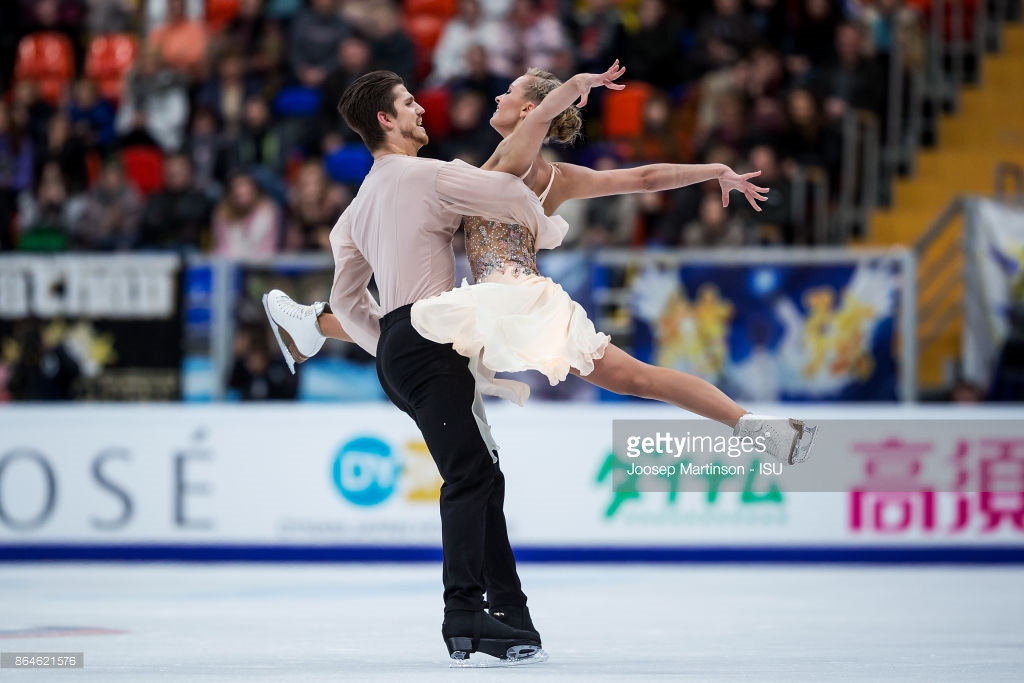
The Grand Prix season has begun, and it feels strange to watch the opening event from home. This is the first year in a long time that Skate America has not kicked off the series, with Russia hosting the inaugural event instead. Regardless of location, one thing always stands out about the first Grand Prix competition: nobody is quite ready for it. Even as the Challenger Series has created broader opportunities for athletes to iron out their programs earlier in the autumn, everyone looks shaky in October. I have plenty of notes on the ladies’ and men’s competitions, but they mostly boil down to that – everyone was a mess. The podiums in the singles disciplines were more or less as expected, and even the winners would most likely rather forget these performances and move on.
The one discipline where the top contenders looked ready to go was ice dance, and that’s part of why I have the most to say about dance this week. There were missteps here and there – and a couple of big disappointments – but it looked more like January than October for the teams at the top of the rankings.
The most anticipated performances of the weekend were by Maia and Alex Shibutani, largely because they were one of the few teams to skip the Challenger Series and debut their new programs at the Grand Prix. Strategically, this seems to have been wise: they looked rested and ready, and their overall score bested everything so far except for Virtue and Moir’s astronomical total at the Autumn Classic. Their choice of programs is also strategic, especially their free dance, a Coldplay medley that recalls the “Fix You” program that became a signature piece for them a couple of seasons ago. Some skating fans get irritable when athletes recycle choreography or themes, but it’s a smart decision in an Olympic year. Most four-year fans missed “Fix You” the first time around, and the Shibs can rest assured that they’re presenting an interpretive style that the judges are on board with.
Instead of innovating artistically, they’ve made notable technical upgrades to their lifts, and they have this season’s tricky Rhumba* pattern dance down cold. The Shibs are still having trouble earning maximum levels on their step sequences, though, and I’m hesitant to blame that entirely on the judges’ pickiness. I saw several missed edges in their free dance step sequences, and I’m not convinced that Alex’s one-foot section in their circular step sequence clearly shows all four types of difficult turns. They’ve confirmed that they’re among the strongest contenders for an Olympic medal this winter, and even have an outside shot at gold – but they have some technical refinements to work on between now and February.
* I’ve noted on Twitter, but not here, that the ISU’s official name for the pattern dance is Rhumba, while the standard spelling for the dance style in general is rumba. When it comes to concerns about ISU policies and practices, their inability to spell in Spanish is pretty far down my list.
I probably shouldn’t be surprised that Ekaterina Bobrova and Dmitri Soloviev snagged silver, since they were the second-ranked team at the competition and were skating on home ice. But their fellow Russians, Alexandra Stepanova and Ivan Bukin, stole their thunder, and a different judging panel might not have respected the pecking order so much. Stepanova and Bukin beat Bobrova and Soloviev’s technical mark by several points, but Bobrova and Soloviev received a program components advantage that left the two teams virtually tied in the free dance. In past decades, Russian ice dancers’ clean, fluid movements were in a class by themselves, but now, teams like Stepanova and Bukin reach Grand Prix podiums despite frenzied performances. There’s a certain beauty to their unkempt style, like strands of hair coming loose from a bun, but their lack of polish stood out. However, Stepanova and Bukin executed their technical elements with admirable precision, raking in high grades of execution even when the transitions and choreographic moves around them looked sloppy. Their distinctive and difficult twizzles earned the highest execution score of the weekend, beating out even the Shibutanis – and I can’t argue. As for their choice of program music, well, it’s been a weekend of Mute and Replace around here anyway.
Seniority aside, Bobrova and Soloviev do present stronger components – they are smoother, faster, and crisper than Stepanova and Bukin – but I was surprised that the judges gave them the benefit of the doubt on so many elements. Their twizzles ticked off all the boxes for a level 4 and were solid enough, but compared to the Shibutanis or to Stepanova and Bukin, the element was nothing special; the judges nonetheless only set them back by a couple of tenths of a point in execution. I’ve long argued that twizzles are the element that will benefit most from a wider range of possible grades of execution, and now I’m starting to think that ice dancers should earn a bonus for placing them in the second half of their free skate, as athletes in the other disciplines do for difficult jumps. Much of the impact of the Shibutanis’ twizzles comes from their late, surprising appearance in the choreography, while Bobrova and Soloviev get their twizzles out of the way early and focus on lifts. Those lifts were terrific this time around, uniquely difficult and with a newfound control. But a botched dance spin so disrupted the flow of their program that it should have impacted their components score. Bobrova and Soloviev’s mistake should have kept them off the podium altogether; Canada’s Gilles and Poirier, as well as Stepanova and Bukin, skated more cleanly and with greater confidence.
Piper Gilles and Paul Poirier’s fourth-place finish inspired a flurry of “wuzrobbed” claims, about which I have mixed feelings. Gilles and Poirier are among my favorite current ice dance teams: they take both artistic and technical risks, and are often an antidote to the tonal and structural sameness that can drag the discipline down. I do think they skated well enough for bronze here – ahead of Bobrova and Soloviev, but behind Stepanova and Bukin. In the free dance, Gilles and Poirier received the same distribution of technical levels as Stepanova and Bukin (and indeed the Shibutanis), but they fell behind on grades of execution. That’s fair enough; Gilles and Poirier were less sharp and less explosive. Their program components did seem low to me, especially since their skating skills and timing showed more maturity and consistency than Stepanova and Bukin’s. Squinting at the protocols, we can see that that a number of judges – the ones from Turkey, Canada, and France – marked the two teams about equally in these components. But some of the other countries – particularly those from Belarus, Russia, and the Czech Republic – favored Stepanova and Bukin by more than a point. Judge #1, from Belarus, awarded an 8.00 for Interpretation/Timing to Gilles and Poirier in the free skate, and a 9.25 to Stepanova and Bukin; Judge #4, from France, split the difference, assigning 8.75 to both. These scores are not so wildly divergent as to trigger a review, but they do indicate that some judges had a clear preference that impacted the results, and that might have reflected subjective taste rather than which team demonstrated greater speed, control, and engagement.
The problem is that – despite preferring Gilles and Poirier in general – I thought Stepanova and Bukin performed better on the day. Gilles and Poirier have been uncharacteristically restrained this season. After two consecutive seasons of iconic and off-the-wall short dances, their short dance this season is a fairly conventional Latin number, spiced up only by a costume transformation trick. Their film noir free dance is a terrific high concept, but they haven’t figured out how to sell it yet. Gilles needs to find her inner Rita Hayworth, Poirier needs to choose between Humphrey Bogart smoothness and Raymond Burr earthiness, and both of them need to take notes on a bunch of old movies. I love the program’s potential, but they’ve performed it a bit flat so far.
One of the ways I get through the figure skating season is by muting program music I dislike or am sick of, and replacing it with whatever is on my current personal playlist. What started out as a mental health defense mechanism has turned into a tool for analysis, so I’m going to close out this post with a pair of transformed warhorses. Charlene Guignard and Marco Fabbri skated with a smoothness and confidence that many other teams lacked at Rostelecom, but their “Exogenesis” free skate is a dull disappointment. When they’re playful and lighthearted, as in their Grease short dance last season and their Lord of the Dance free dance a few years ago, they sparkle. But for some reason, they keep gravitating toward ponderous themes that interpret familiar music in the same old ways. By re-soundtracking their current free dance to “Province” by TV on the Radio, I gave them a song with a similar tempo and narrative theme, but with more drive and energy. While you can occasionally tell they’re skating to something more serious, the choreography lines up startlingly well with the song I assigned them. It shows that the problem isn’t with the warhorse itself, but with the specificity of their interpretation. They’re responding to the ethereal loveliness and the tension in the Muse song, but they’re not telling its particular story, or adjusting it to create a dynamic between two people. Guignard and Fabbri are a talented team with a history of fading into the middle of the ranks, and I think this failure to project a consistent, memorable personality is a big part of that. They should have been in the conversation for a medal at Rostelecom but weren’t, and that’s largely because their artistry seldom brings out their technical gifts as it should.
I doubled down on TV on the Radio for Betina Popova and Sergey Mozgov’s Carmen free dance, and not just because someone really needs to skate to TVotR one of these days. The tempo change in the bridge of “Wolf Like Me” doesn’t quite line up with the cuts in the original music, but it’s pleasingly close. Besides, if any team could rock a werewolf-themed free dance, it’s these two. Even with the familiar music swapped out, Popova is Carmen all the way, using her face and body to give as much fierce Spanish seductress as her choreography and technical content leave room for. There are times when both skaters are concentrating more on their lifts and steps than on their characters – understandable for a young and newly formed team – but Popova’s acting skills accentuate Mozgov’s, and their connection is unusually strong for a team at their stage of development. But the Carmen comes from them, not from the choreography itself. Substitute growls and scratches for smolders and wrist flicks, and we would have a werewolf romance on our hands. Popova and Mozgov make a meal out of surprisingly bland choreography, but that’s a mountain they shouldn’t have to climb.
Next on The Finer Sports: the Grand Prix of Figure Skating continues with Skate Canada!
*Hat tip to my friend Buffy for the post title, and for the gift of the word “feelsiness.”
